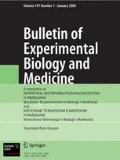We studied activity of lysosomal cysteine proteases, cathepsins B and L, in brain structures (frontal cortex, caudate nucleus, hippocampus, and hypothalamus) of C57Bl/6J mice with aggressive and depressive-like behavior formed under conditions of chronic social stress (repeated experience of victories and defeats within 20 days). Mice with depressive-like behavior showed increased activity of cathepsin В in the hypothalamus and nucleus caudatus and increased activity of cathepsin L in the hippocampus compared to control animals not subjected to agonistic confrontations. In mice with aggressive behavior, protease activity in the studied brain structures was not changed. In 4 h after immune system activation with LPS (250 μg/kg), cathepsin L activity in the hippocampus of control mice increased in comparison with mice receiving saline. In contrast to control animals, LPS caused a decrease in activity of the enzyme in the caudate nucleus and frontal cortex of aggressive mice and in the hippocampus of mice with depressive-like behavior.
Similar content being viewed by others
References
Avgustinovich DF, Marenina MK, Zhanaeva SY, Tenditnik MV, Katokhin AV, Pavlov KS, Sivkov AY, Vishnivetskaya GB, Lvova MN, Tolstikova TG, Mordvinov VA. Combined effects of social stress and liver fluke infection in a mouse model. Brain Behav. Immun. 2016;53:262-272.
Brown GC, Vilalta A. How microglia kill neurons. Brain Res. 2015;1628(Pt B):288-297.
Czibere L, Baur LA, Wittmann A, Gemmeke K, Steiner A, Weber P, Pütz B, Ahmad N, Bunck M, Graf C, Widner R, Kühne C, Panhuysen M, Hambsch B, Rieder G, Reinheckel T, Peters C, Holsboer F, Landgraf R, Deussing JM. Profiling trait anxiety: transcriptome analysis reveals cathepsin B (Ctsb) as a novel candidate gene for emotionality in mice. PLoS One. 2011;6(8):e23604. doi: https://doi.org/10.1371/journal.pone.0023604.
Hook V, Funkelstein L, Wegrzyn J, Bark S, Kindy M, Hook G. Cysteine Cathepsins in the secretory vesicle produce active peptides: Cathepsin L generates peptide neurotransmitters and cathepsin B produces beta-amyloid of Alzheimer’s disease. Biochim. Biophys. Acta. 2012;1824(1):89-104.
Karanges EA, Kashem MA, Sarker R, Ahmed EU, Ahmed S, Van Nieuwenhuijzen PS, Kemp AH, McGregor IS. Hippocampal protein expression is differentially affected by chronic paroxetine treatment in adolescent and adult rats: a possible mechanism of “paradoxical” antidepressant responses in young persons. Front. Pharmacol. 2013;4:86. doi: https://doi.org/10.3389/fphar.2013.00086.
Kölsch H, Ptok U, Majores M, Schmitz S, Rao ML, Maier W, Heun R. Putative association of polymorphism in the mannose 6-phosphate receptor gene with major depression and Alzheimer’s disease. Psychiatr. Genet. 2004;14(2):97-100.
Kudryavtseva NN. The sensory contact model for the study of aggressive and submissive behaviors in male mice. Aggress. Behav. 1991;17(5):285-291.
Moon HY, Becke A, Berron D, Becker B, Sah N, Benoni G, Janke E, Lubejko ST, Greig NH, Mattison JA, Duzel E, van Praag H. Running-induced systemic cathepsin B secretion is associated with memory function. Cell Metab. 2016;24(2):332-340.
Pišlar A, Božić B, Zidar N, Kos J. Inhibition of cathepsin X reduces the strength of microglial-mediated neuroinflammation. Neuropharmacology. 2017;114:88-100.
Pišlar A, Kos J. Cysteine cathepsins in neurological disorders. Mol. Neurobiol. 2014;49(2):1017-1030.
Ramirez K, Fornaguera-Trías J, Sheridan JF. Stress-induced microglia activation and monocyte trafficking to the brain underlie the development of anxiety and depression. Curr. Top. Behav. Neurosci. 2017;31:155-172.
Shigematsu N, Fukuda T, Yamamoto T, Nishioku T, Yamaguchi T, Himeno M, Nakayama KI, Tsukuba T, Kadowaki T, Okamoto K, Higuchi S, Yamamoto K. Association of cathepsin Edeficiency with the increased territorial aggressive response of mice. J. Neurochem. 2008;105(4):1394-1404.
Tholen S, Biniossek ML, Gansz M, Ahrens TD, Schlimpert M, Kizhakkedathu JN, Reinheckel T, Schilling O. Double deficiency of cathepsins B and L results in massive secretome alterations and suggests a degradative cathepsin-MMP axis. Cell. Mol. Life Sci. 2014;71(5):899-916.
Väänänen AJ, Salmenperä P, Hukkanen M, Miranda KM, Harjula A, Rauhala P, Kankuri E. Persistent susceptibility of cathepsin B to irreversible inhibition by nitroxyl (HNO) in the presence of endogenous nitric oxide. Free Radic. Biol. Med. 2008;45(6):749-755.
Zhou R, Lu Y, Han Y, Li X, Lou H, Zhu L, Zhen X, Duan S. Mice heterozygous for cathepsin D deficiency exhibit maniarelated behavior and stress-induced depression. Prog. Neuropsychopharmacol. Biol. Psychiatry. 2015;63:110-118.
Author information
Authors and Affiliations
Corresponding author
Additional information
Translated from Byulleten’ Eksperimental’noi Biologii i Meditsiny, Vol. 164, No. 10, pp. 418-422, October, 2017
Rights and permissions
About this article
Cite this article
Zhanaeva, S.Y., Rogozhnikova, A.A., Alperina, E.L. et al. Changes in Activity of Cysteine Cathepsins B and L in Brain Structures of Mice with Aggressive and Depressive-Like Behavior Formed under Conditions of Social Stress. Bull Exp Biol Med 164, 425–429 (2018). https://doi.org/10.1007/s10517-018-4004-2
Received:
Published:
Issue Date:
DOI: https://doi.org/10.1007/s10517-018-4004-2


